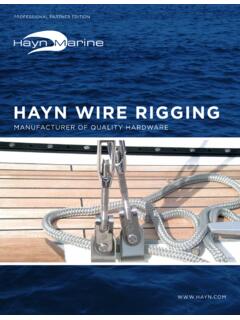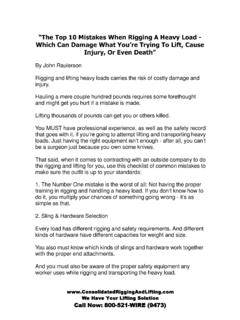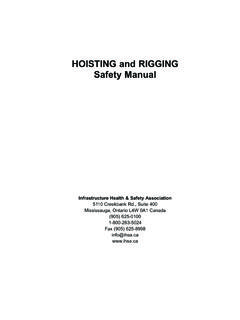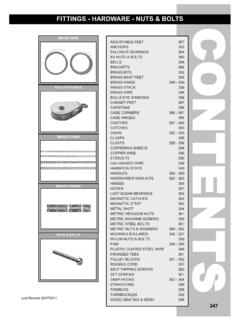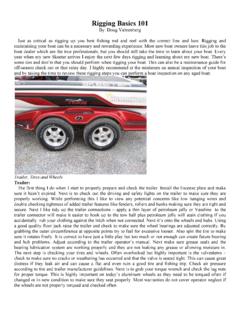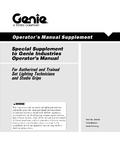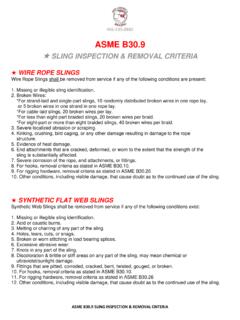Transcription of A Guide To Rigging The Classic Lido 14 John …
1 A Guide To Rigging The Classic Lido 14 by John Papadopoulos The following Guide describes the basics of Rigging a Lido 14 sailboat. If you need more detail, please don t hesitate to contact the author via E-mail at Plugs: Though not Rigging related, there are 4 plugs on most Classic Lido 14s. The primary plug is usually in the transom but can also be found forward of the centerboard trunk in very early models. The purpose of this plug is to drain the cockpit. Please install this from the inside of the cockpit! Lido 14s built prior to about 1962 only had flotation via the seats, which are air tanks.
2 After 1962, an additional air tank was fitted in the bow of the boat also called the bow tank. All air tanks have a hole in them to drain water that may collect inside the tank. The holes are plugged with ordinary stopper corks. Check the tanks for water by tipping the bow upward and downward and seeing if any water flows out. Always remove the air tank corks when going up or down in altitude so that the pressure doesn t build up in the tanks. Stepping the mast: First, always inspect the shrouds for damage (see Bits & Pieces reference below) Pass the lower end of each shroud wires thru the deck fittings located approximately 1' aft of the mast near the gunwales.
3 Place the terminal fitting on the end of the shroud wire inside the channel of the shroud chain plate and fasten with a 3/16 diameter clevis pin. Do not use a threaded screw as anything other than an emergency substitute for the clevis pin. Do not use quick releasing pins either as they are prone to failure. Fasten the upper end of the mast, using a #10 stainless steel machine screw (aka shroud bolt) and a locking nut, to the mast. The holes for the shroud screw are located about 52 from the top of the mast tube.
4 With the mast set so that the leading edge is up and the base of the mast nestled in the mast hinge (that means the head of the mast is sticking out beyond the transom), pass a 5/16" stainless steel bolt through the hinge, through the mast, and into the opposing side of the hinge. Tighten so that the bolt is firm (won't come out on its own) but don t tighten to the point where you start to bend the hinge sides inward. The length of the bolt should be such that there isn't any threads protruding from the far side of the hinge.
5 I recommend that you secure the boat so that you can safely walk in and round the cockpit. Once inside the cockpit, lift the mast upward. Once vertical, secure the forestay to the bow fitting and (and only then) let go of the mast. This can be done by one person if they are careful with their footing as they step from the cockpit up onto the bow of the boat. This task is most often completed with two people one to lift and one to attach the forestay. Advanced sailors of the Classic Lido 14 use another means of stepping that avoids having to get into the cockpit that works when the boat is on a trailer however it is somewhat dangerous.
6 This technique calls for one person to stand near the transom and to lift the mast upward. Another person checks that the shrouds and other Rigging lines are free and clear of snagging, grabs the forestay, pulls on the forestay, and tells the person at the transom to toss the mast up into the air. The person holding the forestay continues to pull so that the mast rotates into its final vertical position. He then attaches the forestay. If either person doesn t to their job well, the mast will crash downwards. So don't do this until you have it all figured out (no tangles, etc.)
7 It is always best to step the mast before putting the boat in the water! Use the reverse of the sequences to lower the mast. Installing The Gooseneck: There are two versions of gooseneck hardware: the Classic gooseneck slide and the 6000 Series system. The Classic gooseneck consists of a very weird looking piece of metal that slides up and down the mast track. It probably has several hooks on it though many have had the hooks removed. The 6000 Series gooseneck is fabricated from stainless steel and forms a universal joint that is permanently affixed to the mast.
8 A Guide To Rigging The Classic Lido 14 by John Papadopoulos Regardless of gooseneck vintage, the proper position of the gooseneck is such that the top edge of the gooseneck is at the height of the top edge of the black band on the mast. If you don't have a black band on the mast, there should be a 3/4" wide one (made from black electrical tape!) positioned so its top edge is precisely 203" from the top of the mast extrusion. This puts the top of the band approximately 15" up from the bottom of the mast. If you have a Classic gooseneck, it is very wise to rig it so that it stays at the desired altitude.
9 There are two methods to achieve this: 1) Insert a 3/8" wide dowel (12" long) into the mast track and tap it down towards the base of the mast. This will serve as a pedestal to keep the slide from dropping down. 2) Insert a screw (or similar) into the mast track to stop the slide from dropping down. The dowel is preferred for the simple reason that you don t have to drill holes in your mast. Main Halyard: Halyard is typically part rope, part wire. Attach shackle to headboard of sail and hoist sail up track. Take the loose end and cleat to the starboard cleat built into the side of the mast hinge.
10 Put the excess halyard into the tray. Jib Halyard: There are two common configurations: Single and multiple purchase. The more common of the two is the multiple purchase system. It consists of a halyard which is typically part rope, part wire, and a stainless steel block joining the two. For this configuration, there should be a cleat mounted on the side of the mast somewhere near the bottom of the mast - port side. If there isn't a cleat, you can't rig multiple purchase. If there is no cleat, rig in the same manner as the main halyard.
